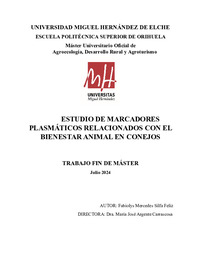Please use this identifier to cite or link to this item:
https://hdl.handle.net/11000/33270Estudio de marcadores plasmáticos relacionados con el bienestar animal en conejos
| Title: Estudio de marcadores plasmáticos relacionados con el bienestar animal en conejos |
| Authors: Silfa Feliz, Fabiolys Mercedes |
| Tutor: Argente, María José |
| Editor: Universidad Miguel Hernández |
| Department: Departamentos de la UMH::Tecnología Agroalimentaria |
| Issue Date: 2024-07 |
| URI: https://hdl.handle.net/11000/33270 |
| Abstract: El bienestar animal está relacionado con la sensibilidad al estrés y a las enfermedades, así como con la resiliencia. Este estudio tiene como propósito analizar los marcadores plasmáticos relacionados con la respuesta inmunitaria en conejos para entender mejor su bienestar. La investigación se ha centrado en dos líneas de conejos seleccionadas divergentemente por resiliencia, con el objetivo de identificar diferencias significativas y posibles mecanismos subyacentes que contribuyen a la variabilidad en el tamaño de la camada. La resiliencia se ha medido como la variabilidad del tamaño de la camada dentro de la misma hembra. La hipótesis es que la línea de conejos con baja variabilidad en el tamaño de la camada (línea low) tiene una mayor adaptabilidad a los cambios ambientales, lo que se traduce en una mejor respuesta inmunitaria a enfermedades en comparación con la línea de conejos con alta variabilidad en el tamaño de la camada (línea high). El objetivo principal de este estudio es caracterizar los perfiles hematológicos de las dos líneas de conejos seleccionadas divergentemente por resiliencia, mediante el análisis del recuento de glóbulos blancos, glóbulos rojos y plaquetas. Además, se busca determinar la capacidad de respuesta inmunitaria de ambas líneas en dos momentos cruciales de su vida reproductiva: la primera monta y el primer parto. Los resultados obtenidos mostraron diferencias significativas en los parámetros hematológicos y en el peso entre líneas, sexo (machos y hembras), estación del año (otoño, invierno y primavera) y estado fisiológico (primera monta y primer parto). Las diferencias entre las líneas low y high mostraron que la línea high tenía un mayor recuento de glóbulos blancos y un menor porcentaje de neutrófilos en comparación con la línea low. Los machos presentaron mayores valores en el recuento de glóbulos rojos, hemoglobina, hematocrito, glóbulos blancos y porcentaje de linfocitos en comparación con las hembras. Las diferencias estacionales indicaron que el recuento de glóbulos rojos, hemoglobina, hematocrito y plaquetas fueron menores en primavera que en otoño e invierno, posiblemente debido a la mayor proliferación de patógenos en esta estación. Además, se observó que, tras el parto, las hembras experimentaron una reducción en el recuento de glóbulos rojos, la concentración de hemoglobina y el hematocrito, junto con un incremento en el recuento de glóbulos blancos y el porcentaje de neutrófilos, reflejando el estrés fisiológico del parto. Estos hallazgos resaltan la importancia de considerar múltiples factores al evaluar la salud hematológica y el bienestar general de los conejos Animal welfare is related to sensitivity to stress and disease, as well as resilience. This study aims to analyze plasma markers related to immune response in rabbits to better understand their welfare. The research has focused on two lines of rabbits divergently selected for resilience, with the aim of identifying significant differences and possible underlying mechanisms contributing to variability in litter size. Resilience has been measured as within-female variability in litter size. The hypothesis is that the line of rabbits with low variability in litter size (low line) has a higher adaptability to environmental changes, resulting in a better immune response to disease compared to the line of rabbits with high variability in litter size (high line). The main objective of this study is to characterize the hematological profiles of the two lines of rabbits divergently selected for resilience by analyzing white blood cell, red blood cell, and platelet counts. Additionally, the immune responsiveness of the two lines at two crucial times in their reproductive life, first mating and first parturition, was also investigated. The results obtained showed significant differences in hematological parameters and weight between lines, sex (males and females), season (autumn, winter, spring), and physiological state (first mating and first parturition). Differences between the low and high lines showed that the high line had a higher white blood cell count and a lower neutrophil percentage compared to the low line. Males had higher values for red blood cell count, hemoglobin, hematocrit, white blood cell count, and percentage of lymphocytes than females. Seasonal differences indicated that red blood cell counts, hemoglobin, hematocrit, and platelet counts were lower in spring than in autumn and winter, possibly due to increased pathogen proliferation in spring. In addition, it was observed that, after parturition, females experienced a reduction in red blood cell count, hemoglobin concentration, and hematocrit, along with an increase in white blood cell count and neutrophil percentage, reflecting the physiological stress of parturition. These findings highlight the importance of considering multiple factors when assessing the hematological health and general welfare of rabbits |
| Keywords/Subjects: Conejos Neutrófilos Respuesta inmunitaria Bienestar animal Selección divergente |
| Knowledge area: CDU: Ciencias aplicadas: Agricultura. Silvicultura. Zootecnia. Caza. Pesca: Veterinaria. Explotación y cría de animales. Cría del ganado y de animales domésticos |
| Type of document: info:eu-repo/semantics/masterThesis |
| Access rights: info:eu-repo/semantics/openAccess |
| Appears in Collections: TFM- M.U en Agroecología, Desarrollo Rural y Agroturismo. |
.png)

